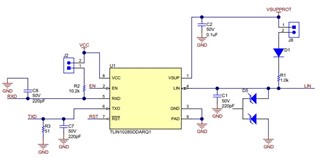Hi TI Team,
I'd like to request the TLIN10285DRQ1 design review for replacement of MELEXIS LIN transceiver. My customer is trying to replace LIN transceiver from MELEXIS to TI, and they want to know if the attached schematic can be used without major change. Are there any points that need to change or delete in attached schematic?
LIN Transceiver_TLIN10285DRQ1.pdf
Regards,
Jeffrey


